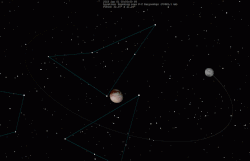Binary companion (minor planets)

When binary minor planets are similar in size, they may be called "binary companions" instead of referring to the smaller body as a satellite. [5] Good examples of true binary companions are the 90 Antiope and the 79360 Sila–Nunam systems. Pluto and its largest moon Charon are sometimes described as a binary system because the barycenter (center of mass) of the two objects is not inside either of them, but Charon is small enough compared to Pluto that it is usually classified as a moon. [6] Orcus and its moon Vanth also orbit around a barycenter not inside either of them. The Sun and Jupiter orbit a point outside of either, but are not considered a binary because they are different kinds of objects.